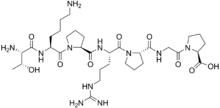Selank
 | |
| Clinical data | |
|---|---|
| Routes of administration | Nasal muscosa, IV |
| Legal status | |
| Legal status |
|
| Identifiers | |
| |
| Synonyms | Selanc; L-threonyl-L-lysyl-L-prolyl-L-arginyl-L-prolylglycyl-L-Proline |
| CAS Number |
129954-34-3 |
| PubChem (CID) | 11765600 |
| ChemSpider |
9940290 |
| Chemical and physical data | |
| Formula | C33H57N11O9 |
| Molar mass | 751.89 g·mol−1 |
| 3D model (Jmol) | Interactive image |
| |
| |
| | |
Selank (Russian: Cеланк) is a nootropic, anxiolytic peptide based drug developed by the Institute of Molecular Genetics of the Russian Academy of Sciences. Selank is a heptapeptide with the sequence Thr-Lys-Pro-Arg-Pro-Gly-Pro. It is a synthetic analogue of a human tetrapeptide tuftsin.
Pharmacology
Selank is a synthetic analogue of the immunomodulatory peptide tuftsin; as such, it mimics many of its effects. It has been shown to modulate the expression of Interleukin-6 (IL-6) and affect the balance of T helper cell cytokines.[1] It has been shown to influence the concentration of monoamine neurotransmitters[2] and induce metabolism of serotonin.[3][4] Selank has also been found to rapidly elevate the expression of brain-derived neurotropic factor (BDNF) in the hippocampus of rats.[5]
Selank, as well as a related peptide drug, Semax, have been found to inhibit enzymes involved in the degradation of enkephalins and other endogenous regulatory peptides, and this action may be involved in their effects.[6] It has also been found to affect the activity of carboxypeptidase H and phenylmethylsulfonylfluoride-inhibited carboxypeptidase in rat nervous system tissue.[7]
Selank has been found to produce antidepressant-like effects in animal models of depression and anhedonia.[8]
Clinical trials
In clinical trials, the drug has shown to provide a sustained nootropic and anxiolytic effect which is useful for the treatment of generalized anxiety disorder (GAD).[1] Selank has an advantage over traditional anxiety treatments, such as benzodiazepines, as it has no sedating or negative cognitive side effects and no associated addiction or withdrawal problems.
Selank is closely related to another nootropic drug, Semax, also developed by the Institute of Molecular Genetics in Russia. This drug is currently available in Russian and Ukrainian pharmacies.[9]
As with all lipophilized peptides, it needs refrigeration to remain stable within sterile water solutions, such as bacteriostatic water concentrations.
See also
References
- 1 2 Uchakina, O. N.; Uchakin, P. N.; Miasoedov, N. F.; Andreeva, L. A.; Shcherbenko, V. E.; Mezentseva, M. V.; Gabaeva, M. V.; Sokolov, O. U.; Zozulia, A. A.; Ershov, F. I. (2008). "Immunomodulatory effects of selank in patients with anxiety-asthenic disorders". Zhurnal nevrologii i psikhiatrii imeni S.S. Korsakova / Ministerstvo zdravookhraneniia i meditsinskoi promyshlennosti Rossiiskoi Federatsii, Vserossiiskoe obshchestvo nevrologov [i] Vserossiiskoe obshchestvo psikhiatrov. 108 (5): 71–75. PMID 18577961.
- ↑ Narkevich, VB; Kudrin, VS; Klodt, PM; Pokrovskiĭ, AA; Kozlovskaia, MM; Maĭskiĭ, AI; Raevskiĭ, KS (2008). "Effects of heptapeptide selank on the content of monoamines and their metabolites in the brain of BALB/C and C57Bl/6 mice: a comparative study". Eksperimental'naia i klinicheskaia farmakologiia. 71 (5): 8–12. PMID 19093364.
- ↑ Semenova, T. P.; Kozlovskiĭ, I. I.; Zakharova, N. M.; Kozlovskaia, M. M. (2010). "Experimental optimization of learning and memory processes by selank". Eksperimental'naia i klinicheskaia farmakologiia. 73 (8): 2–5. PMID 20919548.
- ↑ Semenova, T. P.; Kozlovskiĭ, I. I.; Zakharova, N. M.; Kozlovskaia, M. M. (2009). "Comparison of the effects of selank and tuftsin on the metabolism of serotonin in the brain of rats pretreated with PCPA". Eksperimental'naia i klinicheskaia farmakologiia. 72 (4): 6–8. PMID 19803361.
- ↑ Inozemtseva, LS; Karpenko, EA; Dolotov, OV; Levitskaya, NG; Kamensky, AA; Andreeva, LA; Grivennikov, IA (2008). "Intranasal administration of the peptide Selank regulates BDNF expression in the rat hippocampus in vivo". Doklady biological sciences : proceedings of the Academy of Sciences of the USSR, Biological sciences sections / translated from Russian. 421: 241–3. doi:10.1134/s0012496608040066. PMID 18841804.
- ↑ Kost NV; Sokolov OIu; Gabaeva MV; et al. (2001). "Semax and selank inhibit the enkephalin-degrading enzymes from human serum". Bioorg. Khim. (in Russian). 27 (3): 180–3. doi:10.1023/A:1011373002885. PMID 11443939.
- ↑ Solov'ev VB, Gengin MT, Sollertinskaia TN, Latynova IV, Zhivaeva LV (2012). "[Effect of selank on the main carboxypeptidases in the rat nervous tissue]". Zh. Evol. Biokhim. Fiziol. (in Russian). 48 (3): 254–7. PMID 22827026.
- ↑ Sarkisova KIu, Kozlovskiĭ II, Kozlovskaia MM (2008). "[Effects of heptapeptide selank on genetically-based and situation-provoked symptoms of depression in behavior in WAG/Rij and Wistar rats, and in BALB/c mice]". Zh Vyssh Nerv Deiat Im I P Pavlova (in Russian). 58 (2): 226–37. PMID 18661785.
- ↑ Institute of Molecular Genetics: Translation of